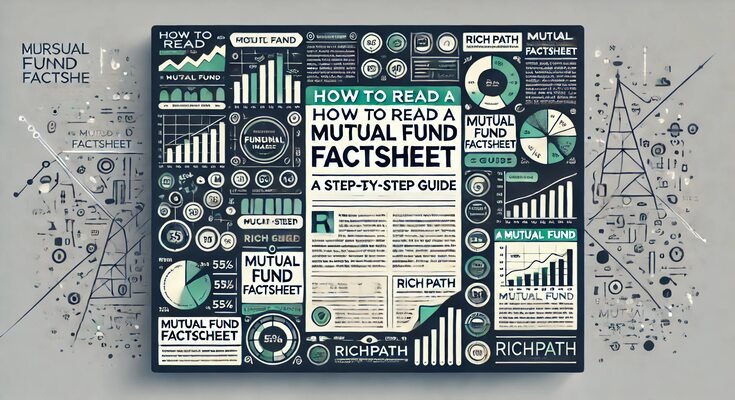How to Read a Mutual Fund Factsheet: A Step-by-Step Guide

Mutual fund factsheets are essential documents for investors. They provide detailed information about the fund’s performance, objectives, holdings, and other critical details. For any investor, knowing how to read a mutual fund factsheet is a vital skill. This guide will help you understand how to interpret the various sections of a mutual fund factsheet effectively.
If you’re new to investing or want to sharpen your skills, this comprehensive guide is tailored for you. Let’s dive in!
What Is a Mutual Fund Factsheet?
A mutual fund factsheet is a summary document released by fund houses monthly or quarterly. It provides:
- Key information about the fund’s objectives.
- Past performance metrics.
- Asset allocation and portfolio holdings.
This document helps investors make informed decisions by presenting all relevant data in a concise format.
Why Is a Mutual Fund Factsheet Important?
Mutual fund factsheets:
- Aid in Decision Making: They give a clear snapshot of the fund’s historical performance and investment strategy.
- Enhance Transparency: Investors gain insight into where their money is invested.
- Compare Funds: Factsheets allow easy comparisons between different funds.
Step-by-Step Guide to Reading a Mutual Fund Factsheet
1. Fund Overview
The first section provides an overview of the mutual fund. Look for:
- Fund Name: Ensure it matches your chosen fund.
- Fund Type: Whether it is equity, debt, or hybrid.
- Fund Objective: This outlines the fund’s purpose (e.g., capital appreciation, income generation).
Example:
For a fund like HDFC Flexi Cap Fund, the objective might state: “To generate long-term capital appreciation by investing in a diversified portfolio.”
2. Fund Manager Details
The factsheet mentions the fund manager’s name, qualifications, and tenure. A fund manager’s expertise plays a crucial role in the fund’s performance.
Practical Tip:
Funds managed by experienced managers with consistent performance records are usually a safer bet.
3. Fund Performance
This section displays the historical returns of the fund compared to its benchmark index. Look for:
- 1-Year, 3-Year, 5-Year Returns: Compare these with the fund’s benchmark.
- CAGR (Compound Annual Growth Rate): A crucial metric to understand the growth rate of your investment.
Example:
Suppose a fund factsheet shows:
- Fund Return (5 years): 12% CAGR
- Benchmark Return (5 years): 10% CAGR
This indicates the fund outperformed its benchmark.
4. Asset Allocation
This part reveals how the fund’s assets are distributed across different categories like equities, debt, and cash.
Equity Allocation:
- Sectors: Check the industries in which the fund has invested.
- Stocks: Look for the top holdings (e.g., Reliance Industries, TCS).
Debt Allocation:
- Credit Quality: Check the credit ratings (AAA, AA, etc.).
- Maturity Profile: Understand the average maturity of the debt instruments.
Example:
For an equity fund, the asset allocation might look like this:
- Equity: 85%
- Debt: 10%
- Cash: 5%
5. Top Holdings
Factsheets list the fund’s top investments, typically in stocks or bonds.
- Check if the holdings align with your investment goals.
- Avoid funds with concentrated investments in a single stock or sector.
Example:
For a diversified equity fund, the top holdings might include:
- Infosys: 8%
- HDFC Bank: 7%
- ICICI Bank: 6%
6. Expense Ratio
This metric shows the annual fee charged by the fund house for managing your investment. Lower expense ratios mean higher returns for you.
Practical Insight:
Equity funds typically have an expense ratio of 1.0–2.0%, while debt funds range between 0.5–1.0%.
7. Risk Measures
Factsheets include metrics like standard deviation, beta, and Sharpe ratio to indicate risk.
- Standard Deviation: Measures the fund’s volatility.
- Beta: Indicates sensitivity to market movements.
- Sharpe Ratio: Assesses risk-adjusted returns (higher is better).
Example:
A fund with a beta of 0.9 is less volatile than the market, making it a good choice for conservative investors.
8. Investment Style
Some factsheets display the fund’s style using a style box, indicating:
- Market capitalization (large-cap, mid-cap, small-cap).
- Investment approach (growth, value, or blend).
9. Benchmark Comparison
Every mutual fund is benchmarked against an index like NIFTY 50 or BSE 200. Compare the fund’s performance to its benchmark for better understanding.
10. Additional Metrics
Other essential metrics to consider:
- Turnover Ratio: Indicates how frequently the fund manager trades assets.
- AUM (Assets Under Management): Reflects the fund’s size.
Common Mistakes to Avoid While Reading a Factsheet
- Ignoring Risk Factors: High returns often come with high risks.
- Overlooking Expense Ratios: They can significantly impact long-term returns.
- Not Comparing Funds: Always compare similar funds before investing.
Conclusion
Reading a mutual fund factsheet is an indispensable skill for investors. By understanding each section of the factsheet, you can make informed decisions and align your investments with your financial goals.
For expert financial insights, visit Rich Path. and start your investment journey today! 🚀
Read more –
Top 5 Mutual Funds for Long-Term Growth in India in 2025
Best Mutual Funds: How to Choose – A Complete Guide
Best Flexi Cap Mutual Funds to Invest in 2025
Did this article help you? Like, share, and comment below to let us know your thoughts or suggest topics you’d like us to cover!
Did you find this article helpful? Like this article and let us know in the comments if you’d like us to cover other topics. Your feedback helps us serve you better!








